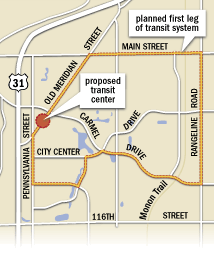Subscriber Benefit
As a subscriber you can listen to articles at work, in the car, or while you work out. Subscribe Now
Carmel’s virtual Disney World of new, high-density attractions—from the mixed-use City Center to the Carmel Arts
and Design District—were built with walking and biking access in mind.
A recently completed study shows the potential to link numerous other city destinations by multiple forms of transportation.
It’s a departure from the automobile-centric model that’s guided development in the region for nearly a century.
The Multimodal System Plan for the city of Carmel designates five multimodal districts, each with its own circulator route.
Each route would connect to a central route in the city’s core.
The central circulator would come first. It would link destinations such as the Arts District and City Center, with a primary
transit center proposed for northeast of the intersection of Old Meridian and Pennsylvania streets.

The transit center could later become a link to commuter rail service being studied to link Indianapolis and Hamilton County.
Currently, an IndyGo commuter bus runs from near the proposed transit center site in Carmel to downtown Indianapolis.
The plan, prepared for Carmel by Indianapolis-based Storrow Kinsella Associates, was funded by a federal transportation planning
grant and the city of Carmel. The plan was conducted at the behest and help of the Indianapolis Metropolitan Planning Organization,
a federally mandated entity that oversees transportation planning in the Indianapolis region.
Carmel City Councilor Ron Carter said he, Mayor Jim Brainard and other leaders have for years been floating the concept of
a circulator in Carmel.
An early idea was a British-style double-decker bus. More recently, out East, Carter saw a system of small, railed vehicles
that take passengers to a destination on a self-directed basis—merely with the push of a button.
“I’d love something of that nature,” Carter said.
He’s quick to point out that the multimodal plan has not been adopted by the city. For now it’s fodder for discussion.
As a starting point, the plan recommends the central circulator start with rubber-tired vehicles “to allow shuttle-scale
service distances” and flexibility in adjusting routes.
The recommendation for the next one to three years is to apply for funding for the central circulator, to develop transit
incentives for employees and then to launch the service.
Ultimately, as development increases, a fixed-rail system could be considered.
The central circulator would be bounded on the west by Pennsylvania and Old Meridian streets, on the north by Main Street,
on the east by Rangeline Road, and on the south by parts of College Drive/Congressional Boulevard/West Carmel Drive.
“The circulators also support organizing downtown transportation services into walkable zones that allow workers, visitors
and residents to move from place to place with and without a car,” states the plan.
A second phase would add more circulators serving such destinations as Clay Terrace, Central Park West-Monon Center and Gramercy-Merchant
Square.
Mo Merhoff, president of the Carmel Chamber of Commerce, said she can imagine the potential of the thousands of people who
work in Carmel’s business district lining U.S. 31 grabbing a quick shuttle for lunch or other activities in the heart
of Carmel.
Such convenient transportation is also a selling point in attracting businesses to a region, she noted.
“It won’t happen overnight,” said Merhoff, who was on an advisory panel to the plan. “Let’s
get it on the table” for discussion.
Hamilton County already has a basic public transportation system, Hamilton County Express, operated by Janus Developmental
Services. Janus has not been asked about the possibility of providing shuttle service at this point, said President and CEO
Connie Sanders, who also served on the advisory panel.
“We would certainly look at the opportunity to do that. It would be manageable for us,” she said of the 22-vehicle
fleet funded primarily by the federal government and Hamilton County.
Janus recently expanded Hamilton County Express into northern Marion County, to link up with IndyGo routes in Castleton.
The Carmel report “is a very interesting exercise,” said Ehren Bingaman, executive director of the Central Indiana
Regional Transportation Authority. The agency is studying the potential of a diesel light rail line between Indianapolis and
Noblesville, using the former Nickel Plate line. An environmental impact study, which is a prerequisite to applying for federal
funding, should be finished by mid-2011. A link to Carmel is envisioned later.
While Carmel’s study is less about regional transportation and more about making it easier to navigate Carmel, it’s
valuable in getting residents to think about transit’s potential here, Bingaman said.
“It would be great if there were more local communities that value local mobility enough to do their own studies”
like this, Bingaman said.
Carmel residents have already gotten a taste of transit’s potential. Besides Hamilton County Express, a coach bus known
as IndyGo Commuter Express—or ICE—runs from downtown Indianapolis to the Meijer store in Carmel. A federal grant
that pays for the bulk of the service expires at year-end, however.
Bingaman said talks are under way with officials in Carmel and in Fishers, which also has ICE service, about coming up with
replacement funding to continue service.
“We’ve demonstrated that that particular mode seems to work well,” Bingaman said.
The Carmel multimodal plan recommends that the city explore the former interurban corridor along College Avenue, south of
the Carmel core. It could connect both north to Westfield and south to Broad Ripple and downtown Indianapolis.
The 2010 City of Carmel Multimodal System Plan can be found at www.indympo.org/Plans/Local/Pages/home.aspx.•
Please enable JavaScript to view this content.
